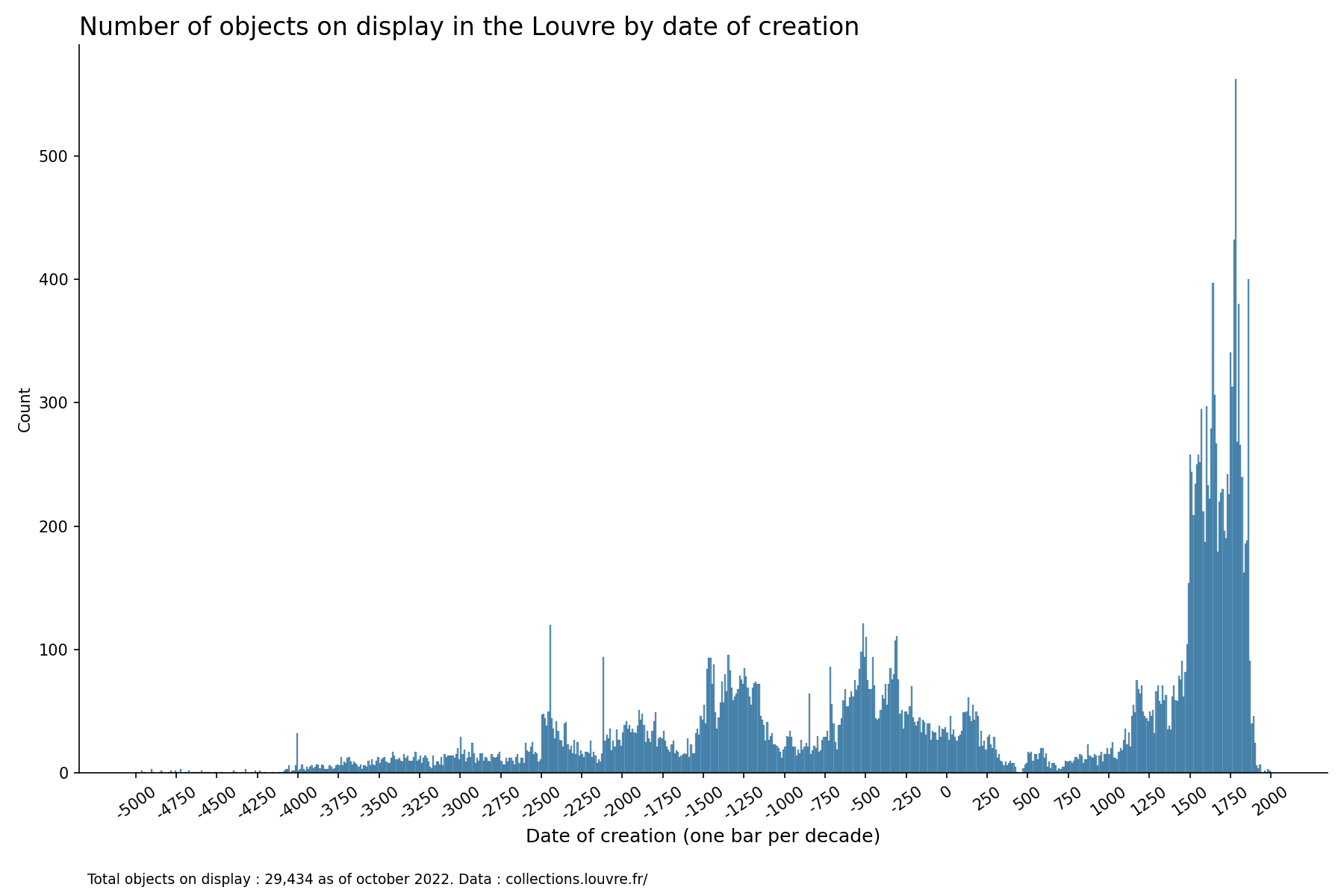Submitted by df_iris t3_yjbd04 in dataisbeautiful
Comments
IvanIsOnReddit t1_iumx6fx wrote
I’m impressed by the sheer amount
IvanIsOnReddit t1_iumx9ur wrote
Interesting the lack of middle age objects
TheFinestPotatoes t1_iumybwg wrote
They don’t call it the Dark Ages for nothing
685327593 t1_iun07hh wrote
Would be interesting to compare the Louvre (a European museum) to The National Museum of China. The profile might be quite different given the highs and lows of Chinese history compared to European history.
markireland t1_iun4y7s wrote
Add an overlay of art movements and empires
coldcynic t1_iunmw2o wrote
No self-respecting historian has called them that in decades.
KmartQuality t1_iunn28t wrote
This isn't r/askhistorians
coldcynic t1_iunnbdo wrote
And how is that a reason to promote long-disproved notions?
df_iris OP t1_iuntbeg wrote
And almost all of the objects from 750 to 1000 AD are from the Islamic department.
MasterFubar t1_iuo06fr wrote
Then explain the gap. Are you saying no self-respecting historian works at the Louvre?
coldcynic t1_iuo0zr9 wrote
Very few historians, for a start. Custodians and art historians are a different category.
The gap reflects what's on display rather than what's held by the museum. The display is shaped by the pop history tastes of the public. Not to mention the Louvre simply specialises in the periods more known to the average tourist. Also, if you actually look at the graph, the late Roman period is the true nadir, followed by the period after Justinian's conquests. If this were an objective representstion of history, the contemporary Islamic and Chinese displays would have to be enormous.
MasterFubar t1_iuo2w6x wrote
The deepest part of the graph is in the 400s, when Rome was sacked, that's when the Dark Ages started. There's a very clear gap in this graph, from the year 200 to 1200. You can't say that this is simply because the average tourist isn't interested in this period. Just look at how many books, films and video games have medieval themes.
Another clear gap is at the Bronze Age collapse, around 1000 BCE. Historians have several different explanations for this collapse, none of them very satisfactory. It is a fact that civilizations collapse from time to time and historians don't have any consistent theory to explain why.
coldcynic t1_iuo48vh wrote
And that's why it doesn't really correlate. In the late 400s, East Rome and the Sassanids were doing just fine, not to mention the "Barbarian" kingdoms. And when you integrate periods, the gap around 476 smooths out. No-one even knew it when Rome fell, it was just a period of increased turmoil and slow institutional decline which was repeatedly slowed down and reversed. At any rate, we're talking about calling the Middle Ages the Dark Ages. The Medieval period wasn't even properly started when we see the lowest portions of the graph.
Tamaska-gl t1_iup3tg9 wrote
They have roughly nothing from the year ~400 or so?
momomosk t1_iup6ol7 wrote
How do/Can I use this tool to find the oldest and newest objects they have?
South_Data2898 t1_iupeow8 wrote
You can see where they got really good at looting.
South_Data2898 t1_iupey98 wrote
There might be more Chinese historical objects at the National Palace Museum in Taiwan.
China went through a pretty hardcore "no fuck you dad" phase around the mid 20th century and destroyed a lot of stuff.
anarchoandroid t1_iupiwwi wrote
I can see the dark ages in this picture and I don't like it.
df_iris OP t1_iuqbhei wrote
You cannot do it directly, I had to do some web scraping to extract the data.
Deucalion111 t1_iuqvalw wrote
I don’t know if it is linked, but in Paris you have the Cluny museum that is dedicated to Middle Ages (and has one of the most important collection of artefacts of this era in the world)
CriticallyThougt t1_iur02am wrote
Wtf happened in the year 400?
carrotsnthrowup t1_ius9pz4 wrote
The dark museum with the tapestries … really glad I went there.
SenecatheEldest t1_iuuwheu wrote
Fall of Rome

df_iris OP t1_iumv8jb wrote
Data : collections.louvre.fr/
Tools : Python, Matplotlib